 A large tomb in the suburbs of Xian City, northwest China, has been identified as the mausoleum of Emperor Wen of the Western Han Dynasty (r.180 – 157 B.C.).
A large tomb in the suburbs of Xian City, northwest China, has been identified as the mausoleum of Emperor Wen of the Western Han Dynasty (r.180 – 157 B.C.).
Local legend has it that a mountain known as Phoenix’s Mouth outside Xian City was the emperor’s tomb. The belief has been pervasive for a thousand  years, as attested by 10 stone tablets on the mountain inscribed with honors to the emperor and a monument to mark his final resting place that was installed on Phoenix’s Mouth during the Qing Dynasty. However, numerous archaeological surveys have unearthed no evidence of ancient construction. The Phoenix’s Mouth is simply a natural hill, not an imperial burial mound.
years, as attested by 10 stone tablets on the mountain inscribed with honors to the emperor and a monument to mark his final resting place that was installed on Phoenix’s Mouth during the Qing Dynasty. However, numerous archaeological surveys have unearthed no evidence of ancient construction. The Phoenix’s Mouth is simply a natural hill, not an imperial burial mound.
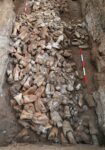 What would prove to be Emperor Wen’s actual tomb was discovered a mile or so away from the mountain in 2017 during an emergency excavation to counter looting activity. It may have originally been a pyramid as was typical of imperial tombs of the era, but if so, the mound was flattened over the millennia. It’s also possible the Emperor ordered a less prominent tomb, as he was famed and respected for his frugal approach to leadership. It wasn’t recognized as an imperial tomb until excavations revealed its shape and monumental size (230 feet long, 100 feet wide).
What would prove to be Emperor Wen’s actual tomb was discovered a mile or so away from the mountain in 2017 during an emergency excavation to counter looting activity. It may have originally been a pyramid as was typical of imperial tombs of the era, but if so, the mound was flattened over the millennia. It’s also possible the Emperor ordered a less prominent tomb, as he was famed and respected for his frugal approach to leadership. It wasn’t recognized as an imperial tomb until excavations revealed its shape and monumental size (230 feet long, 100 feet wide).
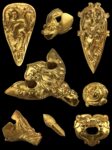 The great central tomb, which has not yet been excavated, is surrounded by more than 110 offering pits and tombs. Only eight of them have been excavated so far, and in them archaeologists have discovered massive quantities of artifacts from the Western Han Dynasty, including more than 1,000 painted ceramic figurines, guardians of the imperial tombs, iron swords, copper gears from chariots, seals of government officials, gold ornaments, animal burials, bronze rings and
The great central tomb, which has not yet been excavated, is surrounded by more than 110 offering pits and tombs. Only eight of them have been excavated so far, and in them archaeologists have discovered massive quantities of artifacts from the Western Han Dynasty, including more than 1,000 painted ceramic figurines, guardians of the imperial tombs, iron swords, copper gears from chariots, seals of government officials, gold ornaments, animal burials, bronze rings and 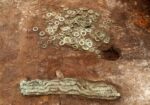 coins. The pottery guardians and attendants, the chariot parts, the weapons and the seals highlight how the mausoleum complex was furnished to create a sort of shadow government for the emperor in the afterlife.
coins. The pottery guardians and attendants, the chariot parts, the weapons and the seals highlight how the mausoleum complex was furnished to create a sort of shadow government for the emperor in the afterlife.
The wealth of offerings are associated with one of the major satellite tombs of the mausoleum. It belonged to Emperor Wen’s mother, Empress Dowager  Bo, who died in 155 B.C., living long enough to see her grandson ascend the throne and making her the first grand empress dowager in Chinese history.
Bo, who died in 155 B.C., living long enough to see her grandson ascend the throne and making her the first grand empress dowager in Chinese history.
Ma [Yongying, a researcher with the Shaanxi Academy of Archaeology,] said that the discovery of the graves of Liu Heng’s empress and his mother further indicated that the grand tomb in the center should be the emperor’s long resting place.
“It is the earliest Western Han royal graveyard in which the emperor’s tomb was put in the center and was surrounded by burial pits,” he said.
The discovery of Baling also means that the whereabouts of all 11 Western Han emperors’ mausoleums in or near Xi’an, then the national capital known as Chang’an, have been confirmed, Ma said.
The grand tomb was a milestone in the evolution of Chinese royal mausoleums, said Liu Qingzhu, an archaeology researcher with the Chinese Academy of Social Sciences.
The emphasis of previous rulers’ mausoleums was more on connections within their own families. For example, royal couples were often buried together.
“But Liu Heng’s tomb reflected that the country, represented by the emperor’s power, was the priority,” he said, adding that studies of the tomb also are a key to understanding the forming of China’s national identity.
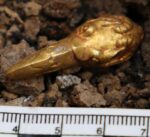
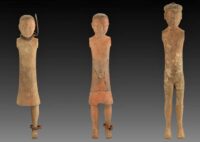
Intrigued by the gear! What did it mesh with and for what purpose? Too many options for speculation!
..presumably, a “Joint Venture”? 😉
Chariot gear? 4-speed with overdrive?
Very interesting, odd that the linked article doesn’t comment on it. Decorative? It is roughly from the time period of the Antikythera mechanism. Would be nice if they found a companion gear.
It would help to know the size of the gear and whether the chariot was a single or a pair vehicle.
One more guess:
Provided that the diameter of that gear is –let’s say– “in the ballpark of 2cm to 10cm”, I would assume some form of ratchet here.
OK, the (missing) metal axis looks rather thin, but maybe there was wood around it.
Either, the open car(riage) simply would have had a roof, or, if there was any weaponry, there might have been some form of catapult or crossbow :skull:
Without the help of welding, I would also expect the center hole to be square shaped if it were to engage any axle no matter what the material.
I would indeed agree to the “square shaped center hole”, but when you look closely, there are additionally four –other– holes, i.e a cylinder with four ‘circular sectors’ (if that’s the correct term).
With particularly a round axis through the center hole, you might end up with some basic form of “freewheel” (again, if that’s the correct term) 😉
Could be an idler gear- forces in and out at different points on its circumference. Used to change the direction of rotation of the driven gear. Driving gear CW, driven CCW. Idler between them becomes CW-CCW-CW.
Or maybe its just decorative.